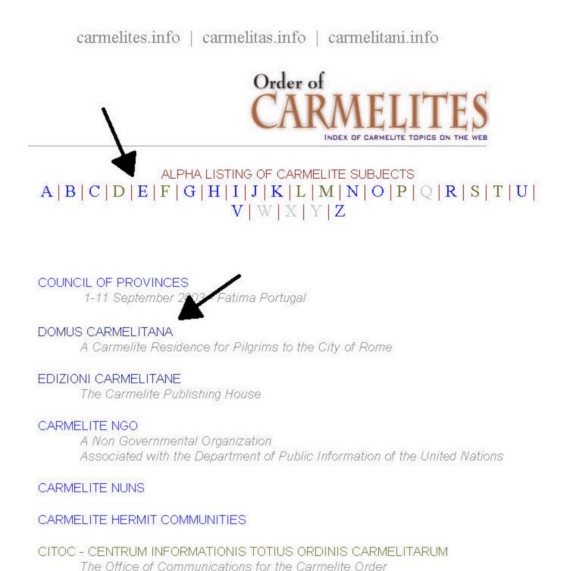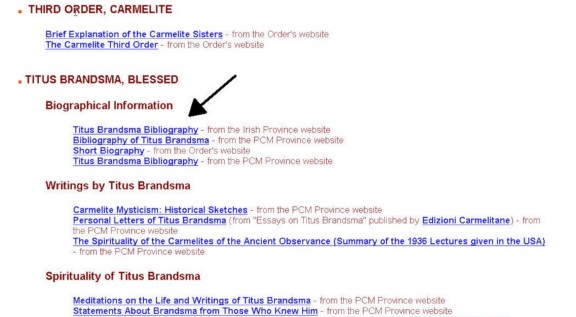|
no. 1 january - march 2004 Carmelite Information on the Internet is Now One Click Away When you last searched for a specific piece of information about the Carmelites on the web, how long did it take you to find what you wanted to know? Asking a major search engine such as "Google.com" to search its files for information on Carmelite saints, a particular monastery of Carmelite nuns, or meetings of the General Council is often a time consuming experience in sheer frustration. Many times, it is also a fruitless experience. In January 2004, leading internet search engine, "Google.com," indexed 3.3 billion pages but estimates are that these search engines only index 15-20% of the existing internet pages.In early 2002, the International Communications Commission examined the implications of this new medium for evangelization, education, research, and its usefulness in developing stronger ties between the various branches of the Carmelite family. The Commission also discussed the decreasing ability to locate specific information on the web easily. As a result, the Commission embarked on a long term project to create a "mega index" making Carmelite information on the internet easily accessible. In less than two years, the project has completed its initial goals. An index of more than 150 Carmelite topics with over 2000 pages is now accessible via the internet in the three official languages of the Order. The five largest Carmelite websites have been fully indexed. "The next important step in the development for the Carmelite mega index—to incorporate information from more Carmelite websites— is now underway," said William Harry, Director of the Office of Communication for the Order (CITOC) and project director. "Over the next 12 months, individual webmasters who wish to become a part of the index will be asked to index their Carmelite website and we will incorporate their information, making it available to anyone who visits the index website." By its nature, the project will never be completed. The index will need to be continually updated to incorporate the additional Carmelite information which is regularly added to Carmelite websites. "The success and functionality of this project is dependent on cooperation between a lot of people," according to Fr. William. "We hope webmasters will continue to develop their own websites. But they will need to let us know that new information. If a webmaster deletes a page or changes the organization of their website, we will need to know that so that visitors to the Index are not frustrated with broken links." The future of the Index? "We hope to find people who are interested in translating the Index into other languages such as French, Portuguese, and German," said Fr. William. "Now that the basic structure is in place, expanding into other languages should not be too difficult to do." "Of course, we will continue to refine the Index but we feel that we have already taken a gigantic leap at making Carmelite information on the internet more accessible. We will continue asking webmasters to put links to the Index in prominent positions on their page. But I am astonished at the number of people who are already using the Index. I think it may be an indication of how many people in the world really are interested in Carmelitana." How to use the Carmelite Mega Index 1) Go to the website of the Carmelite Mega Index: carmelites.info for English; carmelitas.info for Spanish; carmelitani.info for Italian.
2) From the main page, you can select an individual letter of the alphabet (2a) or a "major Carmelite theme" (2b).
3) Scroll to the particular topic or link that you would like to view. Click on the words in blue and the page will appear on your screen.
First Ever Virtual Meeting of International Commission -- Internet Provides the Technology A bit of Carmelite history was made on November 3, 2003 when the International Communications Commission"These commission meetings are a very valuable way for the Order to benefit from the ideas and energy of people from around the world. However, those meetings are also expensive, require a lot of time and travel, and some issues cannot be left hanging for months until the commission meets again," said Fr. Joseph Chalmers, the Prior General. "There is no substitute for face to face meetings but they are not always feasible nor the most efficient. Perhaps some of these new technologies can help us get the input from a wide range of people on a more frequent basis." "I think the possibility of ‘virtual meetings’ presents us with great opportunities. It is not the perfect way to have a meeting. But to be honest, it is an additional tool for us to benefit from," commented Fr. William Harry, one of the participants and director of the Office of Communications of the Order (CITOC). "One drawback is that you have to type in what you would normally just say out loud. It goes a little slow at times and after a short time, you don’t type anything but the essentials. But the benefit is that everyone tends to stay ‘on topic.’" During the November meeting, the members reviewed the progress of the various communication projects: CITOC-online, CITOC the news magazine, Edizioni Carmelitane the Order’s publishing house, the Order’s website— ocarm.org, and the Index of Carmelite websites. Two new items were dealt with by the members of the Commission. At the suggestion of the Prior General, the Commission discussed the possibility of sponsoring a symposium on creating Carmelite websites. Rather than a course on how to create websites, this gathering would attempt to identify those elements necessary for quality Carmelite websites. This will be further discussed at the Commission’s next meeting in April, which will also be via the Internet. The members of the Commission also discussed ways the Order might utilize "online discussion groups." According to Fr. William, "Not all new technologies are going to benefit us. But as we work on strengthening this Carmelite Family, I think we owe it to ourselves to see which technologies will help us and then make sure we use them." Anthony Cilia, O. Carm., Named to Internet Provider Board Anthony Cilia, a member of the Carmelite General Curia community and webmaster of the Order’s ocarm.org website, was elected a member of the Peace Communication Network Administrative Council at their December 6, 2003 meeting. The Peace Communication Network is a consortium of religious groups which provides a variety of internet services to its members. The Network was founded in Rome in 1995 and is the internet service provider (ISP) to the Curia and CISA.
|
|
|
RETURN TO THE INDEX FOR 2004 | RETURN TO THE INDEX FOR THIS ISSUE INDEX OF CARMELITE
WEBSITES |


